Hat Creek, A Day in the Life - OW Ranch History
Opening remarks by JoAnn Wade:
Welcome to a Day in the Life at Hat Creek. We invited you here to not only commemorate the 150th anniversary of the soldiers arrival to this very spot, which initiated all of the local happenings and history down through the years, but also to begin the celebration of America’s 250 years as a nation. Earlier this year the county commissioners appointed a committee to lead Niobrara county’s celebration of America’s history. The committee consists of Leslie Stewart, Sanda Johnson, Sheila Bolden, Richard Ladwig, Debbie Sturman, Morgan Nolan, Gary Bayne and myself (JoAnn Wade). Throughout the next year, we have many different experiences planned to showcase our Niobrara County History.
Welcome to the 150th anniversary celebration of the Hat Creek Stage Station!
Ben Hanson's powerpoint of the OW Ranch History is below.
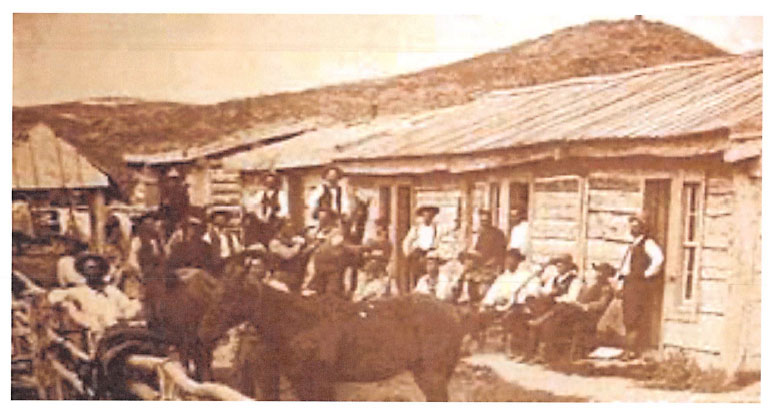
O. C. Wade
Oliver "O.C." Wade is where the OW brand originated. The timeline of his arrival at Hat Creek is a little unclear, but legend says he came during a blizzard with about 100 head of cows and bulls. Some accounts say he had the bulls tied to the wagon or pulling it. Overwhelmed by the storm, Wade turned his stock loose and sought shelter.
He found a draw near a meadow on what would become the present-day ranch. There, he built a dugout: a center post and rafter beam, logs piled on top, covered with pine boughs and dirt. He lived in this crude shelter through the winter, marking the beginning of the OW Ranch.
Local lore also claims that Old Woman Creek was named when someone heard the crying of an old Indian woman along its banks.
Addison Spaugh horseback, late 1800s
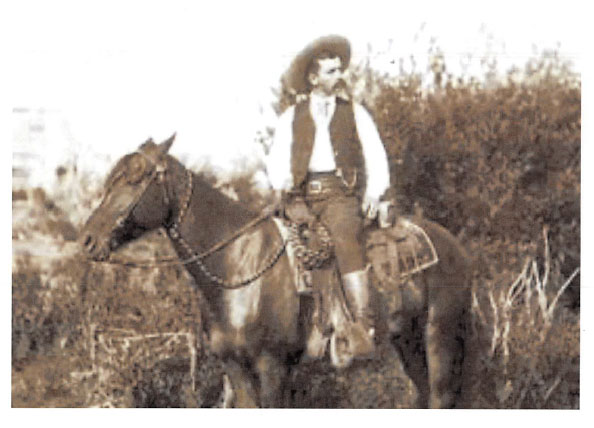
Growth of the OW
Once Manville and Peck secured the OW, things moved quickly. Spaugh collected the 2,000 Oregon steers, and by the end of 1879-just three years after the Custer Massacre-the ranch was running 3,200 head with a resident cowboy crew.
That fall, Spaugh set his men to work building corrals and cabins. One crew of cowboys went out with running gears to haul in spruce and pine for cabin construction, while two others stayed at headquarters, hewing logs with broad axes.
OW Ranch - Cattle on the Range, 1880s
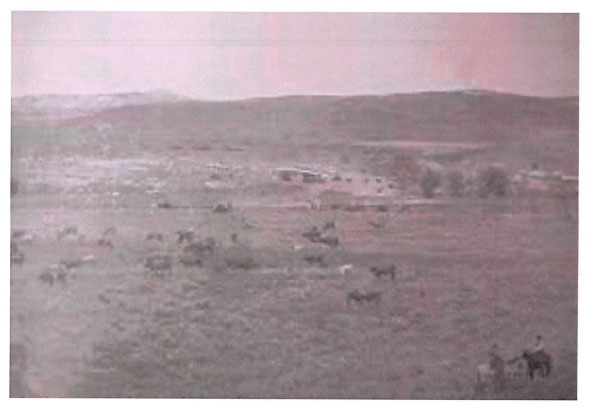
1880 - Converse Cattle Company
In February 1880, Spaugh was summoned to Cheyenne. The OW had been pooled with W.R. Irvine's outfit, financed by Asa Converse, president of the First National Bank of Cheyenne.
The company officers:
- Asa Converse - President
- W.R. Irvine - Vice President
- Peck - Secretary & Treasurer
- Manville - General Manager
- Ad Spaugh - Range Manager
This venture became the Converse Cattle Company, recognized as the first
$1,000,000 range holding-equivalent to about $32 million today. Its domain stretched across 20,000 square miles, from the Nebraska line to Independence Rock.
Hat Creek Confrontation
One day at the Hat Creek stage station, a drunken wagon boss named George picked a fight while Spaugh was branding calves. George reached for his six-shooter, but cowboy Clarence Hand, a quiet, hazel-eyed young man, drew first and leveled his Colt.
"Drop it, or I'll plug you!" he shouted.
George backed down, holstered his gun, and rode away. Spaugh later thanked Clarence, admitting he would likely have been killed if not for him.
Valentine, Nebraska - 1883
In the fall of 1883, Spaugh gathered 6,000 steers for delivery to Valentine, Nebraska, a drive of about 300 miles. After the cattle were delivered, the OW crew went into town to celebrate.
Tragedy struck when Sheriff's bullets killed Clarence Hand-the same cowboy who had once saved Spaugh's life. Tensions flared, and the OW cowboys strapped on their guns, ready for revenge.
Spaugh held them back, ordering his wagon bosses to control the men. With the help of his most trusted hand, Frank Decastro, he managed to round up the remaining crew and prevent bloodshed.
Later that evening, Spaugh and Decastro ran into an ex-employee who had fallen in with a rough group of thieves. Drunk and enraged, the man stepped in front of Spaugh, pulled a gun, and declared he was going to kill him. At the last moment, Decastro struck the man's hand, deflecting the shot. The bullet tore through Spaugh's jacket but missed him. In the same motion, Decastro brought his pistol down across the man's face, knocking him to the ground.
The two quickly mounted up and slipped out of town, returning safely to camp.
Frank Decastro - After the Valentine Fight
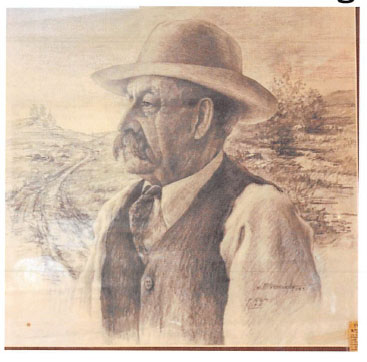
Frank Decastro, who saved Addison Spaugh's life during the 1883 Valentine incident.
OW Ranch, 1884 - Frank Decastro in center
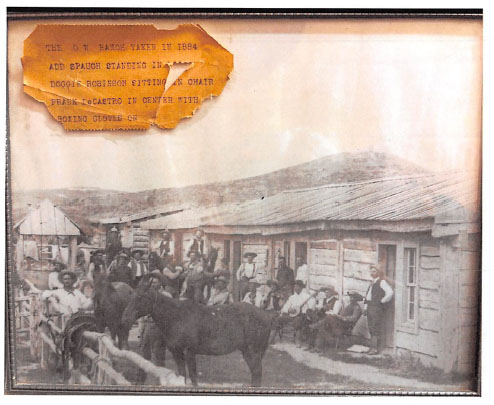
The Famous Roundup of 1884
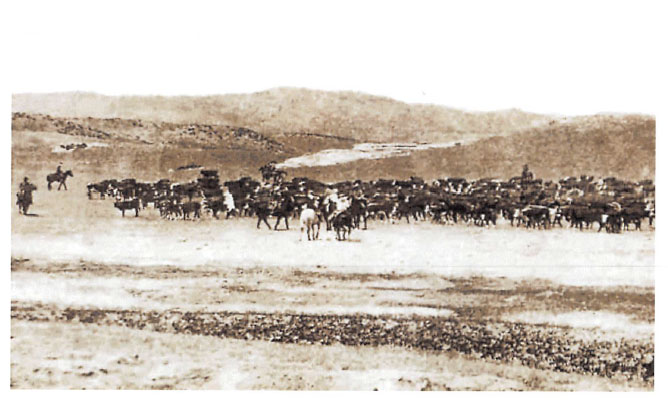
The Famous Roundup of 1884
Participating Cattle Companies (Part 1):
Tom Bell Cattle Co - 15,000 (Lance Creek)
Boyd Bros. (OU) - 10,000 (Cheyenne River)
J. M. Carey & Bro. (CY) - 60,000 (Platte River)
Carlisle Cattle Co (COD) - 10,000 (Powder River)
Concord Cattle Co (COD) - 10,000 (Powder River)
C. F. Coffee (010 Bar) - 10,000 (Hat Creek Basin)
M. 0. Connors (MC) - 8,000 (Powder River)
Converse Cattle Co (OW) - 40,000 (Lance Creek)
Dater Bros. (O Bar O) - 15,000 (Cheyenne River)
Davis & Robins (Spectacle Brand) - 9,000 (Powder River)
J. H. Ford (A) - 12,000 (Cheyenne River)
The Famous Roundup of 1884
Participating Cattle Companies (Part 2):
Plunket Cattle Co (EK) -15,000 (Powder River)
Dr. E. B. Graham (04) - 8,000 (Running Water)
Hammond Cattle Co (4W) - 9,000 (Cheyenne River)
Mike Henry (88) - 8,000 (Cheyenne River)
T. B. Hord (77) - 7,000 (Lance Creek)
Geo. Keeline & Sons (Hog Eye) - 15,000 (Platte River}
Ogallala Cattle Co (Keystone} - 60,000 (Cheyenne River)
Union Cattle Co (Bridle Bit} - 50,000 (Cheyenne River)
Suffolk Cattle Co (AU7) - 25,000 (Cheyenne River)
Circle Bar Outfit - 30,000 (Indian Creek}
Bar T Outfit (Whitcomb) -15,000 (Indian Creek)
Major Wolcott (VR} - 15,000 (Platte River}
The Famous Roundup of 1884
Scale of the Event:
Largest general spring roundup in Wyoming history
200 men, 2,000 horses, 20 wagons
Lasted six weeks
400,000 head of cattle gathered
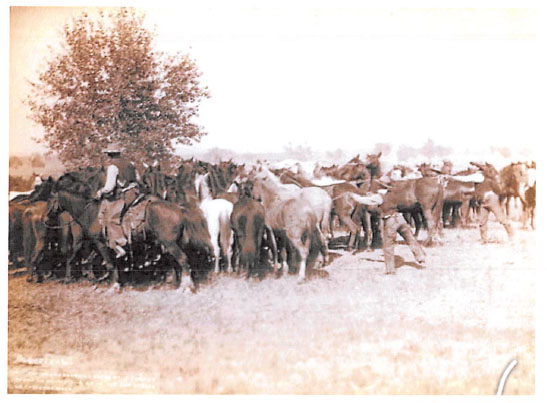
The Famous Roundup of 1884
Leadership:
Foreman: Addison A. Spaugh
Assistant Foreman: Curtis Spaugh (to mouth of Black Thunder)
Foreman: Lee Moore (mouth of Black Thunder onward)
Assistant Foreman: J. B. Moore
The Famous Roundup of 1884
Route of the Roundup (May 15, 1884):
Began at head of Age Creek
OW Ranch ➔ Old Woman Creek ➔ Lance Creek
Harney Creek➔Twenty Mile Creek➔ Walker Creek
Beaver Dams on Lightning Creek➔ Cow Creek
Snyder Creek ➔ Lodge Pole ➔ Black Thunder
Cheyenne River ➔ Antelope Creek
The Beginning of the End
By 1884, the Converse Cattle Company's OW herd had swelled to nearly 40,000 head. At the Cheyenne Club, a broker offered to sell the holdings to a foreign syndicate for $1 million in cash. Spaugh urged his directors to accept, but they refused.
Seeing the range overstocked and trouble ahead, Spaugh sold his stake and resigned as range manager in 1885.
John Kendrick Takes Over
In 1886, John B. Kendrick-a seasoned Texas trail hand who had nearly died of illness on the long drive north-assumed management of the OW.
Though inexperienced as a manager, Kendrick proved capable. He returned profits each year, even in the face of overgrazed ranges and weakened herds. He also convinced the owners to let him invest his wages into his own cattle, something rarely permitted.
In 1889, Kendrick moved the entire OW outfit-cattle, horses, and crew-into the Hanging Woman Creek drainage of southeastern Montana. There he found abundant water, forage, and room for expansion.
Kendrick's Early Political Aspirations
1882: Lost Lance Creek constable election (3 votes out of 22)
1890: Declined seat in Wyoming Territorial legislature
Focused on ranching, banking, and stock growers' leadership
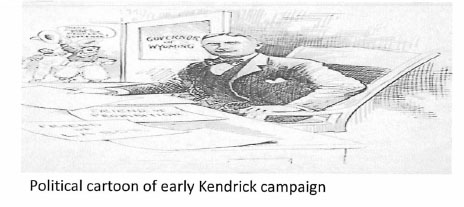
Senator Kendrick
1916: Elected U.S. Senator
Chaired Committee on Public Lands
Served on Agriculture, Forestry, and Irrigation committees
Advocated irrigation, reclamation, land use, natural resources.
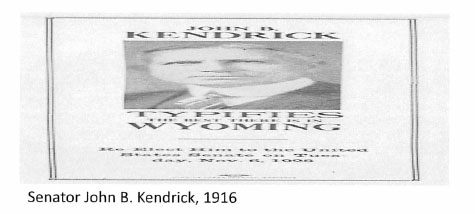
The Kendrick Legacy
- Built the Kendrick Cattle Company (210,000 acres)
- Exposed Teapot Dome scandal corruption
- Advanced worker's compensation & water projects (Alcova, Pathfinder, Seminoe)
• Protected Yellowstone & Tetons
- Served 3 terms in U.S. Senate (1916-1933)
- Died 1933; remembered as one of Wyoming's greatest leaders
